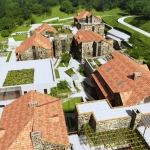Between the four-peaked mountain of Aragats and the biblical Mount Ararat, Armenia’s national symbol of remembrance and hope, lie the fertile lowlands of the Armavir region. Armavir is a symphony of beautiful landscapes, wondrous architecture, hospitable traditions, and momentous history, existing in unity and harmony. The Ararat valley is the largest and the most fertile land of the forty valleys of the historical Armenian highland. At once we are presented with contrasts in the Armavir region: four of the thirteen capitals of Historic Armenia can be found in the same region as the Zvartnots International Airport.
A mere twenty minutes from Yerevan by car is the spiritual center of Armenia, the Holy See of Ejmiatsin, the Mother Cathedral of the world’s oldest Christian nation. Located in the city of the same name which was once the capital of Armenia, Ejmiatsin is the residence of the Catholicos, the head of the Armenian Apostolic Church. According to legend, Jesus Christ descended from heaven and indicated the spot for a church to be built. Holy Ejmiatsin Cathedral was erected at that site in the 4th century (301-303), at the dawn of the Christian conversion of the country by King Trdat III and Saint Gregory the Illuminator. The Cathedral was built on top of the pagan temple of Vagharshapat, after it was destroyed by King Trdat. Armenia was the first country in the world to adopt Christianity as its state religion. A beautiful cathedral, museum, and seminary are among the most significant edifices of this holy site. There are three other major early churches in the town, each of them dedicated to the Christian virgins who were martyred prior to Armenia’s conversion to Christianity.
Saint Gayane Church
The Church of St. Gayane was built in Ejmiatsin by order of the Catholicos Yezr in 630.
Saint Shoghakat Church
Shoghakat church, built in1694, has a domed hall with a three-arch portico topped by a belfry. There is a theory that this church was erected upon the foundation of a much earlier structure.
Saint Hripsime Church
Saint Hripsime Church was built by the order of the Catholicos Komitas in 618. The legend of Hripsime dates from the early days of Christianity.
Hripsime fled to Armenia to escape persecution by the Roman Emperor. A beautiful but totally devoted follower of Christ, Hripsime refused to marry the pagan Armenian King Tirdat III when ordered, and chose the death of a martyr. A small chapel was erected over the spot where she was murdered. The Armavir region can be thought of as a giant Armenian orchard. Apples, apricots, cherries, plums, watermelons, strawberries, raspberries, melons, peaches and many other gifts of nature grow on this fertile land. Of note, both the apricot and the peach are said to have their origins in the Ararat valley. Alexander the Great reportedly introduced apricots to Greece after leading his legendary armies through the Armenian highlands. On the outskirts of Ejmiatsin, another stunning site is the ruins of Zvartnots, a 7th century cathedral and architectural masterpiece that was destroyed during a subsequent earthquake.
The complex consisted of St. George temple or Zvartnots (“vigil forces”, “celestial angels”) and the palace of Catholicos Nerses III, known as “Builder”. The remnants of Zvartnots, even in ruins, are a majestic sight.
The decoration of Zvartnots temple followed the principle, common in the Armenian architecture of the 5th-7th centuries, of bringing out the basic architectural details: columns, door and window openings. On the whole, the motif of sculptural ornamentation was floral (a vine, stylized leaves, branches of pomegranate with fruit, etc.). Zvartnots is a monument which embodies the centuries old traditions of Armenian architects. Zvartnots is an outstanding monument of world architecture, an evidence of the high level of the development of the artistic and engineering thought in the 7th-century Armenia. Its architectural idea later became widely spread and developed in new shapes and new artistic compositions. At the Metsamor Archeological Museum you will have an opportunity to see the impressive collection over 26,000 items nearly ten thousand of which are on permanent display.
A symbol of pride and survival, the Sardarapat Memorial marks the place of Armenia’s successful effort to save the nation from obliteration at the hands of the Turks (May, 1918). On the grounds of the historic battle one can today visit the Sardarapat Ethnography and Liberation Movement History Museum adjacent to the outdoor monument. On the way to Armavir region on the right one can see he monument and museum to the victims of Musaler leroic battle.










